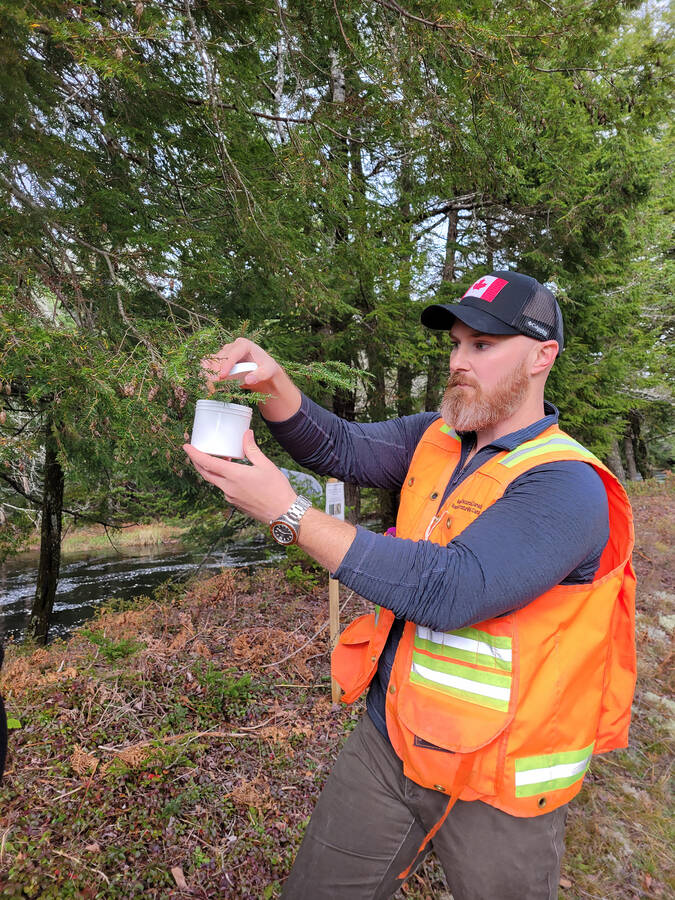
2023-11-08
Another ally in the fight against HWA
by KEVIN MCBAINKEJIMKUJIK - Another ally in the fight against the Hemlock Woolly Adelgid (HWA) was introduced to the hemlock trees recently.
Approximately 3,000 Laricobius nigrinus beetles from British Columbia were released onto the trees in test areas of the park and the area. the beetles are considered natural predators to the HWA, a non-native invasive pest discovered in southwestern Nova Scotia that attack and kill eastern hemlock trees.
HWA is an invasive, aphid-like insect, native to Eastern Asia and the Pacific Northwest. They feed on the storage cells at the base of the needle on the branches of hemlock trees, eventually killing the needles and buds, causing needle loss and stem dieback. The tiny adelgid was discovered in the province in 2017 and in Kejimkujik during the summer of 2018.
The Laricobius nigrinus beetles were recently collected in B.C. by NRCan researchers for release in Nova Scotia. Next fall, the lead researchers of this biocontrol project: Dr. Lucas Roscoe, Dr. Michael Stastny and Jeff Fidgen will evaluate the winter survival rates of the introduced beetle to see how they have established and their impact on HWA populations.
Roscoe, a research scientist with Natural Resources Canada's Atlantic Forestry centre said this is the first of a 10+ year project to monitor the beetle's efficiency on various East Coast forests.
"The goal of this project is to establish some sort of predator population that can track down and manage HWA populations in Nova Scotia," he said. "We just finished a three-year project where we looked at HWA populations in Nova Scotia to see if we could find any predators that would stop their (HWA) populations for exploding and we were unable to see there is essentially none."
The project was to look for ways of combatting HWA and they looked to the Pacific Northwest and British Columbia, where the beetles, who only attack HWA, have been successful in saving trees
"Our recent work indicates that the native natural enemies present in Nova Scotia are not able to reduce populations of HWA to prevent tree decline and loss," says Roscoe in a media release. "During the last 20 years, Laricobius nigrinus has been used in the biological control program for HWA in the eastern United States as part of wider management program."
Researchers hope to see the same positive results in Nova Scotia in a cooler climate, as so many species depend on hemlock trees for various reasons, such as shelter.
THE BEETLES
Roscoe said once the beetle was identified, a team travelled to B.C. this past spring, identified areas where the beetles could be found. About three weeks ago, they returned to go and collect them.
Once collected, they were counted and sorted to make sure that there were no other beetles amongst them. They were then shipped overnight to Nova Scotia in bottles that contained wood chips and moisture to keep them going.
They then began releasing them Oct. 24th in hemlock stands at Kejimkujik and other sites in Queens and Shelburne counties.
HEMLOCK IMPORTANCE
Hemlock trees are extremely important to the areas where they are located and Roscoe indicated that there are a lot of forests in eastern Canada where it is the dominant tree. They are very large, tall trees that can harbour hundreds, if not thousands, of unique species that need "hemlock to survive."
"It is really critical that we try to keep it on the landscape," said Roscoe.
Hemlock stands in Nova Scotia play an important role in the Acadian Forest. They are very old, some up to 400 years of age, and they're unique in terms of being exceptionally tall and large in diameter.
STEM INJECTION
In 2021, workers began treating hemlocks with a injections of imidacloprids into the base of the trees.
Roscoe said this works is still being done and added that the product is "effective" and is protecting the trees, but added that it is not a widespread program and that there are a lot of monetary costs associated with it and a lot of labour that is needed.
He said that it is good for a few trees, but the beetle will be much more effective cost-wise and labour-wise.
"It will find HWA wherever it is. We don't have to go out looking for it," he said.
THE RELEASE
Roscoe explains a bit about the method of releasing the beetles.
"We find a branch that has HWA on it, hang the bucket with the beetles on the end, take the top off, then just let the beetles wand out," he said. "They attack and eat HWA almost immediately.
Once all of the beetles are released their progress will be monitored, then next checked in February or March then in May and October of next year.
COLLABORATION
This project is led by Natural Resources Canada in co-operation with Parks Canada, the Canadian Food Inspection Agency and the Nova Scotia Department of Natural Resources and Renewables.






